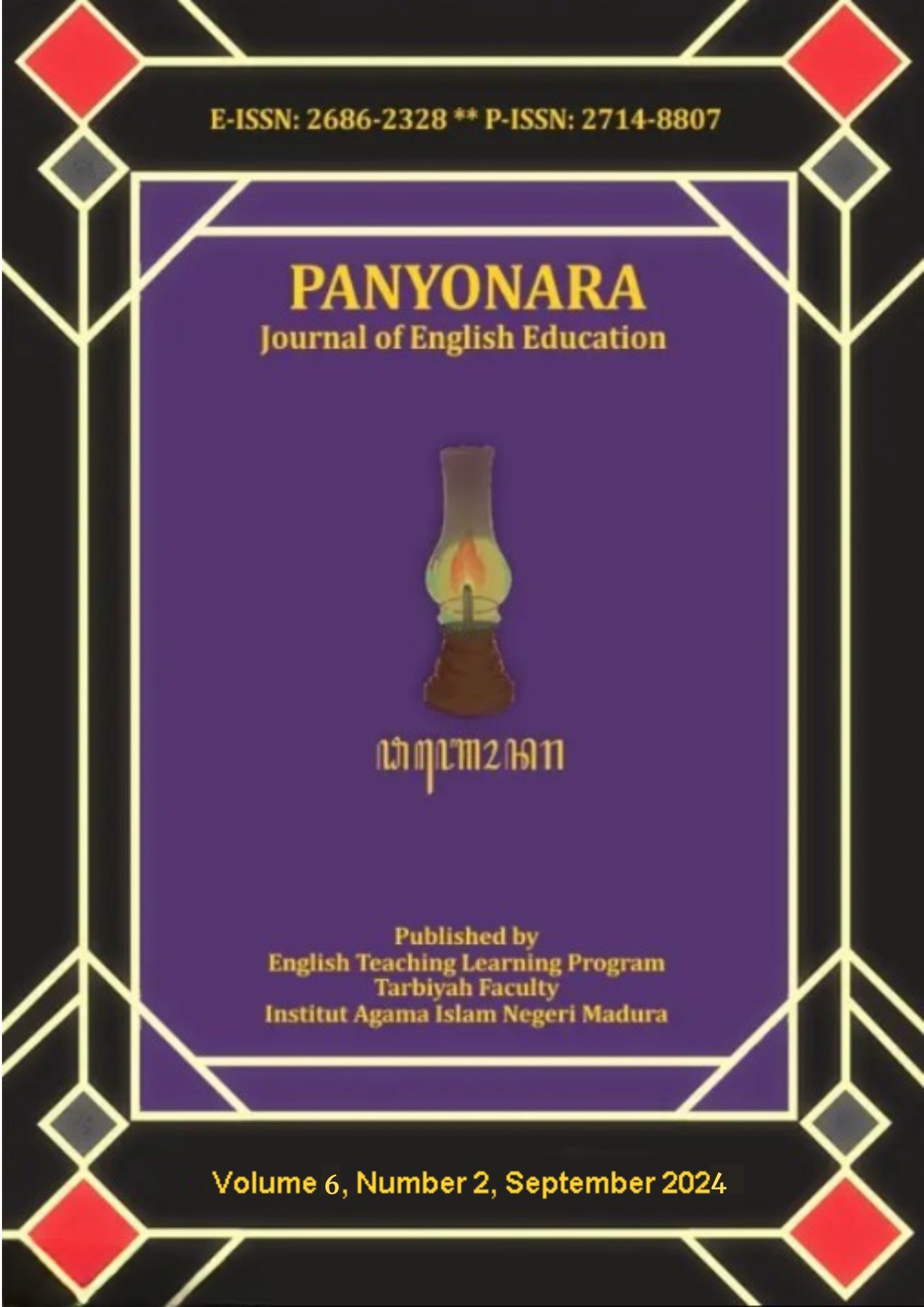Portraying the Students’ Perception on English Speaking Class Activities within Independent Curriculum Implementation: A Photovoice Study
 Abstract views: 212
,
Abstract views: 212
,
 PDF downloads: 186
PDF downloads: 186
Abstract
Abstract: This research aims to explore the senior high school students’ perception on Independent Curriculum implementation in English as a Foreign Language (EFL) classroom, particularly in English-speaking class activities. The shift from the previous curriculum to the independent curriculum resulted in many significant changes for teachers and students. In this case, the English subject experienced a complete change when the independent curriculum was implemented in schools, especially in teaching speaking skill. Using Photovoice research design, the researchers observed the speaking class, analyzed the photos taken by eleven students from three different classes during English-speaking activities and administered in-depth interview to these participants dealing with their photos. This research was conducted at SMAIT Ukhuwah Banjarmasin, South Kalimantan. The findings portrayed that the photos taken by students in the English-speaking class captured memorable, harmonious learning moments that were conducive, communicative, informative, and an accurate depiction of the atmosphere of the English-speaking class. This is further demonstrated from the students’ perspective through their photos showing communicative activities during English-speaking classes since the photos portray a well-organized, positive, engaging, and fun classroom environment as well as emphasizing individual development in line with the independent curriculum demand. The research highlights the effectiveness of the Independent Curriculum in fostering student engagement and communicative activities, suggesting that visual-based methodologies like Photovoice can provide meaningful insights into classroom dynamics
Downloads
References
Adila, A. U., Sari, I. P., & Adiyono, A. (2023). The Role of Teachers in The Development of Islamic Religious Education (PAI) Curriculum in Public Junior High Schools. Pedagogia: Jurnal Ilmiah Pendidikan, 15(1), 1–8. https://doi.org/10.55215/pedagogia.v15i1.8368
Adisti, A. R. (2018). DIGITAL GAME PROJECT FOR TEACHING ENGLISH FOR YOUNG LEARNERS (TEYL). Journal of English Teaching and Learning Issues, 1(1). https://doi.org/10.21043/jetli.v1i1.4509
Alfia, N., Sumardi, S., & Kristina, D. (2021). Integrating Digital Literacy Into EFL Classroom: A Study of Theory of Planned Behavior. JPI (Jurnal Pendidikan Indonesia), 10(3), 535. https://doi.org/10.23887/jpi-undiksha.v10i3.29812
Alshaer, A., O’hare, D., Hoermann, S., & Regenbrecht, H. (2016). Impact of the visual representation of the input device on driving performance in a power wheelchair simulator. Proc. 11th Intl Conf. Disability, Virtual Reality & Associated Technologies.
Andrew, L., Robinson, K., Dare, J., & Costello, L. (2021). Widening the lens on capital: conceptualising the university experiences of non-traditional women nurse students. Higher Education Research & Development, 40(7), 1359–1374. https://doi.org/10.1080/07294360.2020.1815663
Appel, J. (1985). Reviews. ELT Journal, 39(1), 60–61. https://doi.org/10.1093/elt/39.1.60
Aries Denta Putra, Yuyu Yuhana, Maman Fathurrohman, & Asep Muhyidin. (2023). HASIL REVIEW LITERASI - ANALISA MEDIA PEMBELAJARAN BAHASA INGGRIS DI ERA MODERN. BUANA ILMU, 8(1), 73–88. https://doi.org/10.36805/bi.v8i1.6005
Asaba, E., Rudman, D. L., Mondaca, M., & Park, M. (2014). Visual Methodologies. In Qualitative Research Methodologies for Occupational Science and Therapy (1st ed.).
Aswanti, N. H., & Isnaeni, W. (2023). Analysis of critical thinking skills, cognitive learning outcomes, and student activities in learning the human excretory system using an interactive flipbook. Research and Evaluation in Education, 9(1), 37–48. https://doi.org/10.21831/reid.v9i1.53126
Baker, T. A., & Wang, C. C. (2006). Photovoice: Use of a participatory action research method to explore the chronic pain experience in older adults. Qualitative Health Research, 16(10), 1405–1413. https://doi.org/10.1177/1049732306294118
Bekker, T., Bakker, S., Douma, I., van der Poel, J., & Scheltenaar, K. (2015). Teaching children digital literacy through design-based learning with digital toolkits in schools. International Journal of Child-Computer Interaction, 5, 29–38. https://doi.org/10.1016/j.ijcci.2015.12.001
Celce-Murcia, M., Brinton, D. M., Snow, M. A., & Bohlke, D. (2014). Teaching English as a Second or Foreign Language Series (4th ed.). National Geographic Learning.
Chandrawati, T. (2020). Perceptions of Early Childhood Student Teachers towards the Online Tutorial Courses at Universitas Terbuka (UT). Universal Journal of Educational Research, 8(6), 2218–2222. https://doi.org/10.13189/ujer.2020.080604
Copoc, P. (2021). Trigger warnings: A quantitative study on the stigmatization of individuals with a mental illness and university students’ help-seeking intentions. SURG Journal, 13(1). https://doi.org/10.21083/surg.v13i1.6314
Dariyanto, D., & Awiria, A. (2023). Pendidikan Karakter Pada Pembelajaran Percakapan Bahasa Inggris Siswa Sekolah Dasar Berasrama. Educational Journal of Bhayangkara, 3(1), 65–74. https://doi.org/10.31599/edukarya.v3i1.2534
Ford, D. Y., & Kea, C. D. (2017). Creating Culturally Responsive Instruction: For Students’ and Teachers’ Sakes. Focus on Exceptional Children, 41(9). https://doi.org/10.17161/foec.v41i9.6841
Harmer, J. (2001). The Practice of English Language Teaching, 3rd Edition-Longman (3rd ed.).
Harmer, J. (2007). The Practice of English Language Teaching with DVD (4th Edition) (Longman Handbooks for Language Teachers) (4th ed.). Pearson Longman ELT.
Hertiki. (2018). Developing English Teaching Materials for Young Learners. JET ADI BUANA, 3(1), 29–39. https://doi.org/10.36456/jet.v3.n1.2018.1541
Intopiana, A., Nikijuluw, R. C., & Monica, M. (2021). INVESTIGATING STUDENTS’PERCEPTION OF SPEAKING ACTIVITIES IN THE XI GRADE OF SMA NEGERI 19 MBD. KOLI JOURNAL, 2(2), 1–11.
John, H. C., Izang, A., & Owolabi, J. (2018). Smart Classroom: A Panacea for Effective ICT-based Instructional Strategies in Nigerian Medical Colleges. European Journal of Health and Biology Education, 7(2). https://doi.org/10.29333/ejhbe/80717
Khairunnisa, K., Parama Iswari, W., Asih, Y. U., & Mulawarman, U. (2021). Students’ Perception towards Storytelling in Developing Speaking Skills at English Department of Mulawarman University. E3L: Journal of English Teaching, Linguistic, and Literature, 4(2), 89–96.
Mahmudah, F., & Rahmah, U. (2021). CLASSROOM MANAGEMENT APPLIED BY ENGLISH TEACHER AT NINTH GRADE IN THE STATE JUNIOR HIGH SCHOOL 7 JAMBI. JR-ELT (Journal of Research in English Language Teaching), 5(1), 37–49. https://doi.org/10.30631/jr-elt.v5i1.18
Moola, F. J., Norman, M. E., Petherick, L., & Strachan, S. (2014). Teaching Across the Lines of Fault in Psychology and Sociology: Health, Obesity and Physical Activity in the Canadian Context. Sociology of Sport Journal, 31(2), 202–227. https://doi.org/10.1123/ssj.2012-0179
Muhammad, A., Lebar, O., Mokshein, S. E., Mohamed, R., Ridzwan, S., & Khairil, L. F. (2018). Assessing Student Teachers’ Soft Skills Using Rubrics in E-portfolio. International Journal of Academic Research in Business and Social Sciences, 8(10). https://doi.org/10.6007/IJARBSS/v8-i10/5295
Mulyani. (2018). ANALISIS TEKS KOMPETENSI DASAR PADA SILABUS BAHASA INGGRIS SMA/MA/SMAK/MAK KEMDIKBUD 2017. Jurnal Dimensi Pendidikan Dan Pembelajaran, 6(2), 53–59. https://doi.org/10.24269/dpp.v6i2.1016
Mulyasa, E. (2009). Standar kompetensi dan sertifikasi guru.
Nita Yusovi, V., Purwanti, E., & Gresik, Mt. (2023). STUDY ABOUT STUDENT’S PERCEPTION TOWARD THE USE OF SMART TV IN LEARNING SPEAKING ON THE MATERIAL GIVING AND ASKING OF INSTRUCTIONS. PANYONARA: Journal of English Education, 5(1). https://doi.org/10.19105/panyonara.v5i1.7284
Plunkett, R., Leipert, B. D., & Ray, S. L. (2013). Unspoken phenomena: Using the photovoice method to enrich phenomenological inquiry. Nursing Inquiry, 20(2), 156–164. https://doi.org/10.1111/j.1440-1800.2012.00594.x
Rahayu, V. D., Muhtadi, D., & Ridwan, I. M. (2022). Pedagogical Content Knowledge Guru dalam Pembelajaran Matematika Daring. 11(2). http://journal.institutpendidikan.ac.id/index.php/mosharafa
Ramadhevi, M., & Rajaprakash, Dr. S. (2022). AN OVERVIEW ON APPLICATIONS AND DEVELOPMENTS IN EDUCATION ON AGENT BASED ONTOLOGICAL COOPERATIVE LEARNING. Journal of Pharmaceutical Negative Results, 723–728. https://doi.org/10.47750/pnr.2022.13.S06.101
Rohimajaya, N. A., & Hamer, W. (2023). MERDEKA CURRICULUM FOR HIGH SCHOOL ENGLISH LEARNING IN THE DIGITAL ERA. KLAUSA (Kajian Linguistik, Pembelajaran Bahasa, Dan Sastra), 7(1), 1–8. https://doi.org/10.33479/klausa.v7i1.673
Sari, N. M., Setyarini, M., Lengkana, D., & Jalmo, T. (2021). The Use of Vertical Representation in Students’ Science Book on Matter Particles Topic and Its Impact on Students’ HOTS and Visual Literacy. Proceedings of the 2nd International Conference on Progressive Education, ICOPE 2020, 16-17 October 2020, Universitas Lampung, Bandar Lampung, Indonesia. https://doi.org/10.4108/eai.16-10-2020.2305237
Saud, M. S. (2021). Nepalese EFL Teachers’ Digital Literacy for Online Teaching. REiLA : Journal of Research and Innovation in Language, 3(1), 61–70. https://doi.org/10.31849/reila.v3i1.6129
Speranskaya, A. V., Prokopyeva, S. A., & Kornilova, T. V. (2020). The role of the form master’s personality in the formation of the psychological climate of the school team. SHS Web of Conferences, 87, 00023. https://doi.org/10.1051/shsconf/20208700023
Syafik, M., & Raihany, A. (2020). A Comparative Study on English Speaking Skill between Interpersonal and Intrapersonal Students in the Third Semester of English Teaching Learning Program of STAIN Pamekasan. PANYONARA: Journal of English Education, 2(1), 1. https://doi.org/10.19105/panyonara.v2i1.3017
Thilagaratnam, J. S. J., & Yamat, H. (2021). Teachers’ Perception of Students’ Misbehavior and Assertive Discipline in English Classroom. International Journal of English Language Studies, 3(3), 07–15. https://doi.org/10.32996/ijels.2021.3.3.2
Waks, L. J. (1981). The Arts and Personal Growth: Curriculum Issues in Art Education Vol. 1 ed. by Malcolm Ross (review). Harvester Press.
Wang, C., & Burris, M. A. (1997). Photovoice: Concept, Methodology, and Use for Participatory Needs Assessment. Health Education and Behavior, 24(3), 369–387. https://doi.org/10.1177/109019819702400309
Wang, C. C., Cash, J. L., & Powers, L. S. (2000). Who Knows the Streets as Well as the Homeless? Promoting Personal and Community Action Through Photovoice. In Health Promotion Practice (Vol. 1, Issue 1). www.photovoice.com
Wass, R., Anderson, V., Rabello, R., Golding, C., Rangi, A., & Eteuati, E. (2020). Photovoice as a research method for higher education research. Higher Education Research and Development, 39(4), 834–850. https://doi.org/10.1080/07294360.2019.1692791
Yalley, C. E., Amartey, A., & Fynn, D. A. (2020). Effectiveness of Economics Teachers’ Instructional Practices in Senior High Schools in the Cape Coast Metropolis. Journal of Educational & Psychological Research, 2(1). https://doi.org/10.33140/JEPR.02.01.05
Yuhelmi, Y. (2022). PENGGUNAAN MODEL PEMBELAJARAN TWO STAY TWO STRAY PADA MATA KULIAH BELAJAR DAN PEMBELAJARAN UNTUK MENINGKATKAN KETERAMPILAN BERDISKUSI, MAHASISWA PROGRAM STUDI PENDIDIKAN BAHASA INGGRIS DAN PENDIDIKAN SASTRA INDONESIA FKIP UM SUMBAR. Diklat Review : Jurnal Manajemen Pendidikan Dan Pelatihan, 6(2), 161–167. https://doi.org/10.35446/diklatreview.v6i2.1084
Yuniari, N. M., & Sudarmawan, I. P. Y. (2023). Teaching Strategies for Children with Expressive Language Disorder. Jurnal Imiah Pendidikan Dan Pembelajaran, 6(3), 654–664. https://doi.org/10.23887/jipp.v6i3.57791
Zohoorian, Z., & Faravani, A. (2021). Investigating the Patterns of Empathy and Classroom Environment Applied by Effective English Language Teachers. Romanian Journal of English Studies, 18(1), 110–136. https://doi.org/10.1515/rjes-2021-0012
Zuhdi, U. (2019). The Development of Young Learner Material for Teaching English. Proceedings of the 3rd International Conference on Education Innovation (ICEI 2019). https://doi.org/10.2991/icei-19.2019.57
The journal uses an Open Access policy under a Creative Commons Attribution-NonCommercial 4.0 International License. Authors who publish with this journal agree to the following terms:
- Authors retain copyright and grant the journal right of first publication with the work simultaneously licensed under a Creative Commons Attribution License that allows others to share the work with an acknowledgment of the work's authorship and initial publication in this journal.
- Authors are able to enter into separate, additional contractual arrangements for the non-exclusive distribution of the journal's published version of the work (e.g., post it to an institutional repository or publish it in a book), with an acknowledgment of its initial publication in this journal.
- Authors are permitted and encouraged to post their work online (e.g., in institutional repositories or on their website) prior to and during the submission process, as it can lead to productive exchanges, as well as earlier and greater citation of published work.
















